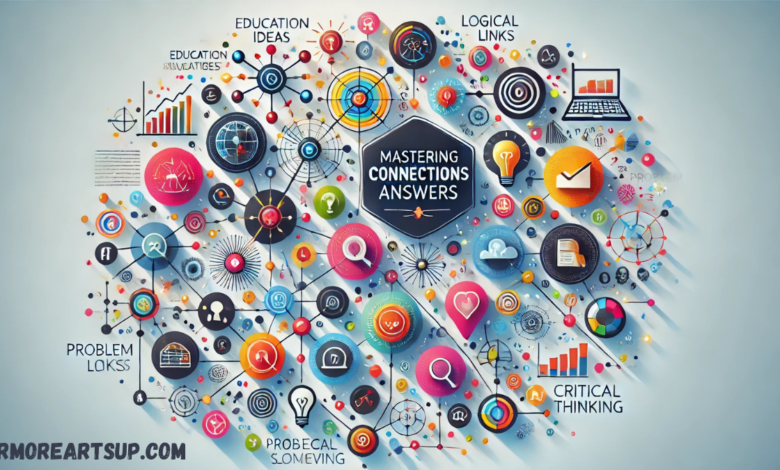Mastering Connections Answers Tips, Strategies

Introduction
In today’s fast-paced world, effectively connections answers ideas, concepts, and information is a valuable skill. Mastering ‘Connections Answers‘ answers can lead to tremendous success and understanding in education, business, communication, and personal development. The term ‘Connections Answers’ answers refers to linking information and ideas cohesively to provide clear, logical, and insightful responses. This skill is beneficial for academic and professional purposes and enhances everyday interactions.
This article aims to provide a comprehensive guide to mastering ‘Connections Answers’ , covering the definition, strategies, challenges, and practical applications. By understanding and implementing the tips and techniques shared here, readers can improve their critical thinking, enhance communication skills, and deliver powerful ‘Connections’ answers in various scenarios.
Understanding Connections Answers
‘Connections Answers involve forming logical links between different pieces of information, ideas, or concepts. They require critical thinking and the ability to analyze and synthesize data to present coherent and meaningful responses. Typical scenarios where ‘Connections Answers are essential include exams, job interviews, presentations, and problem-solving discussions. These answers demonstrate a person’s analytical abilities, comprehension of complex topics, and capacity to articulate thoughts clearly.
Types of Connections Answers
Textual Connections Answers involve linking ideas within written content. They enhance the flow of information, making text more engaging and easier to understand. These Connections Answers can be achieved through transitional phrases, logical progression, and consistent tone throughout the text.
Conceptual Connections Answers
Conceptual Connections Answers are about drawing parallels between different concepts. This skill is handy in educational settings, where connecting theories and ideas can lead to deeper insights and better learning outcomes. It involves finding similarities and differences and creating analogies that simplify complex ideas.
Practical Connections Answers
Practical Connections Answers involve applying theoretical knowledge to real-world scenarios. This type of connection is crucial in professional environments, where demonstrating how concepts translate into practical solutions can showcase problem-solving abilities and strategic thinking.
Emotional Connections Answers
Emotional Connections Answers are about engaging audiences through relatability. This is especially important in storytelling, marketing, and communication, where establishing a bond with the audience can influence perception and behavior.
The Role of Critical Thinking
Critical thinking plays a pivotal role in crafting strong ‘Connections Answers. It involves analyzing information, identifying relationships between ideas, and evaluating the validity of those connections. Enhancing critical thinking skills can lead to more insightful and impactful answers. Techniques to improve essential thinking include questioning assumptions, Connections Answers alternative perspectives, and practicing reflective thinking.
Strategies for Crafting Effective Connections Answers

A critical first step in delivering effective ‘Connections’ answers is accurately analyzing the question or prompt. Understanding what is asked is crucial to providing a relevant and focused response. Breaking down the question into its core components can help identify the necessary connections. This process involves highlighting keywords, recognizing the main topic, and determining the required depth of the answer.
Building Logical Connections
Building logical connections involves establishing clear and rational relationships between ideas. This can be achieved using cause-and-effect reasoning, drawing comparisons, and analogies. Strong connections are built on evidence, logical progression, and consistency. Avoiding vague or ambiguous statements helps maintain the clarity and strength of the connections presented.
Enhancing Clarity and Coherence
Clarity and coherence are key to effective ‘Connections’ answers. Structuring responses logically, using transition words, and maintaining a clear narrative help ensure the answer is easy to follow. Additionally, keeping sentences concise and focused prevents information overload and holds the reader’s or listener’s attention.
Real-World Examples of Strong Connections Answers
Using real-world examples is an excellent strategy to illustrate the effectiveness of strong ‘Connections’ answers. Analyzing case studies from fields such as education, business, or storytelling can provide practical insights into how connections enhance understanding and communication. These examples serve as models for applying the strategies discussed in real-life situations.
Common Challenges and How to Overcome Them
One of the most common challenges in crafting ‘Connections’ answers is misinterpreting the question or prompt. This can lead to irrelevant or off-topic responses. To overcome this challenge, take the time to read and analyze the question thoroughly, ensuring a clear understanding before formulating an answer.
Over-Complicating Answers
While detailed answers are valuable, over-complicating responses with unnecessary information can confuse the audience. Focus on delivering clear and straightforward connections, balancing detail with simplicity.
Lack of Supporting Evidence
Evidence, examples, or logical reasoning often support effective ‘Connections’ answers. Providing concrete support for connections strengthens the credibility of the answer and demonstrates a deeper understanding of the topic.
Managing Time Under Pressure
In situations such as exams or interviews, time constraints can make it challenging to deliver well-connected answers. Practicing time management techniques, such as prioritizing key points and maintaining a structured approach, can help overcome this challenge.
Conclusion
Mastering ‘Connections’ answers requires a blend of critical thinking, analytical skills, and effective communication. By understanding different types of connections, applying strategic approaches, and avoiding common pitfalls, individuals can enhance their ability to provide clear, logical, and impactful answers. Practice and reflection are essential to this process, enabling continuous improvement and confidence in delivering well-connected responses.
FAQs
What are ‘Connections’ answers, and why are they important?
‘Connections’ answers involve linking ideas and information cohesively to create clear and logical responses. They are essential because they demonstrate critical thinking, analytical skills, and effective communication.
How can I improve my ability to make strong connections in my answers?
Improving critical thinking, practicing analyzing prompts, and using real-world examples can enhance your ability to make strong connections in your answers.
What are some common mistakes to avoid when crafting ‘Connections’ answers?
Avoid misinterpreting questions, over-complicating responses, providing unsupported claims, and neglecting time management when crafting ‘Connections’ answers.
Are there specific techniques to develop critical thinking for better connections?
Yes, questioning assumptions, considering alternative perspectives, and practicing reflective thinking can develop critical thinking for better connections.
How can I practice creating effective ‘Connections’ answers in everyday situations?
Engage in activities involving analysis, synthesis, and communication, such as debates, discussions, writing exercises, and solving problems requiring effectively connecting ideas.
You May Also Read: https://livermoreartsup.com/jecizer-biosciences/




